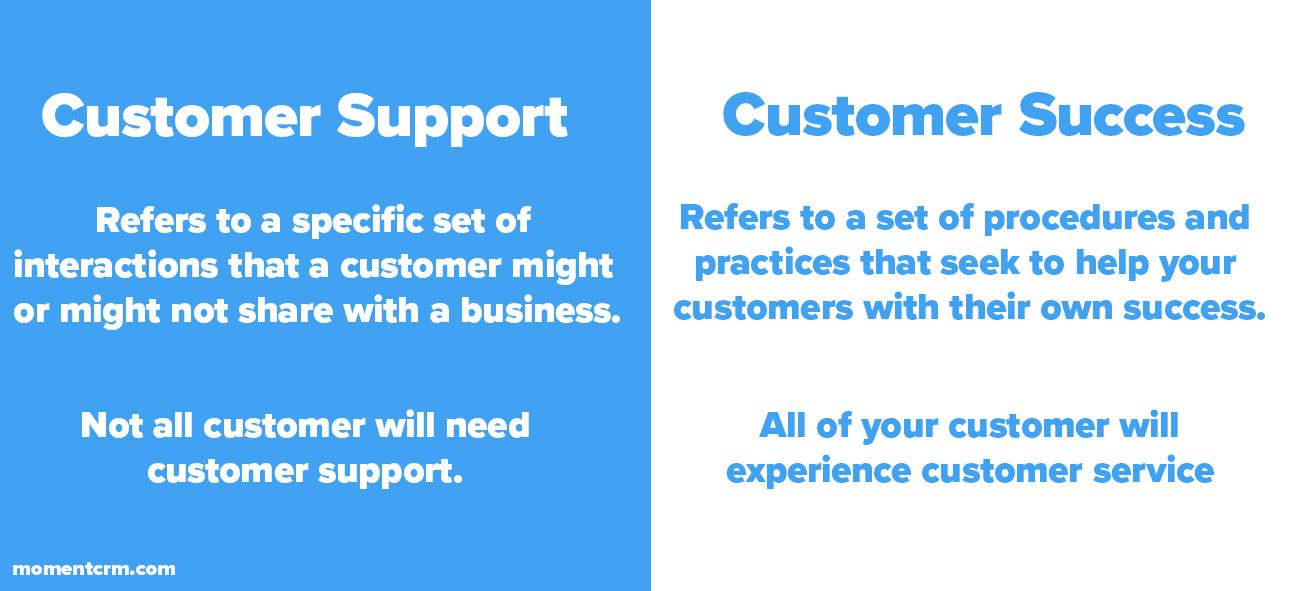Customer Support vs Customer Success: What’s the difference?

Customer Support and Customer Success.
What is the difference between these two terms? It there even a difference at all?
For many, these two terms might as well be the same thing. However, they are intrinsically different and can both play a key role in growing your business.
So, by having a deep understanding of the difference between both concepts, you can better strategize for improvements in both areas that will benefit your business.
Alright, let’s break it all down.
What is Customer Support?
Customer Support refers to a set of procedures and practices that occur only during specific scenarios.
For example, a customer might have specific questions about a product before purchasing or they might run into issues with the product after their purchase.
Here’s where Customer Support comes into play. Customer Support only occurs when a customer requires specific assistance from a business.
It is a reactive approach to solving customer issues and challenges.
What is Customer Success?
Customer Success refers to a set of procedures and practices that seek to help your customers with their own success.
For example, let’s take a company like Shopify, the popular e-commerce platform. The company’s client base is comprised of over one million e-commerce merchants.
As a result, it is in Shopify’s best interest to make sure that their customers are successful. If their customers are successful, they will stay a Shopify customer for longer. Their success is Shopify’s success too!
With this in mind, Shopify puts in motion several strategies that seek to help their merchants through any challenge they might face or that seek to identify uncovered opportunities for their customers.
In the case of large customers, they might be assigned with their own Customer Success manager whose only goal is to see them succeed!
This is what Customer Success is all about, a set of proactive strategies that help your customers get even more value out of your product or service (even when they have not directly asked for it!)
What is the difference between Customer Support and Customer Success?
By now, you should be able to tell the difference between these two terms. But let’s put it into simpler terms.

Customer Support is a reactive practice that seeks to help customers with any issues or concerns they might have that require special assistance.
Customer Success is a proactive practice that focuses on the long-term value that customers get from your product or service, helping them achieve more than they would have otherwise.
The confusion between these two terms stems from their similar wording and the fact that both practices seek to “help” the customer. However, they both have extremely different goals, success metrics, and strategies.
What about Customer Service?
“But wait, what about Customer Service?”, we hear you ask from a distance.
Customer Service is another term that often gets confused with Customer Support and Customer Success.
Customer Service refers to a set of best practices that guarantee a smooth and pleasant interaction between a customer and a business.
As a result, Customer Service is present through every single interaction between the customer and business, including Customer Support and Customer Success interactions.
The confusion between these terms occurs because Customer Support Representatives and Customer Success Managers are usually well-skilled in Customer Service best practices. But so are Sales Reps, Cashiers, Social Media Managers, Marketers and any other employee at your company that deals with customer interactions.
Think of it this way, while Customer Support and Customer Service are drastically different, they both play a part in the overall Customer Service experience offered by your business.
Closing thoughts
Well, that was a lot of explaining.
Hopefully not only do you now have an understanding of all these different concepts, but you’re also thinking about how to implement them in your business.
Which practice will you implement first?
